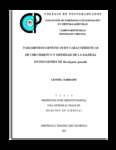| dc.description.abstract | Con el fin de determinar la estructura genética de las características de crecimiento y densidad de la madera (evaluada de manera directa y a través de la penetración del Pilodyn) y estimar la respuesta esperada a la selección masal en una población de Eucalyptus grandis formada por familias del NE de Queensland (Australia), se evaluó un ensayo de progenies a los 4.5 y 8.5 años de edad, establecido en tres sitios del NE argentino. Aunque se encontró una amplia variabilidad genética en todas las características evaluadas, las características de crecimiento [diámetro (DAP), altura (HT) y volumen (VOL)] mostraron diferente estructura y grado de control genético con respecto a las otras características [rectitud de fuste (FORM), proporción de corteza (COR) y penetración de Pilodyn (PILO)]; el efecto de orígenes fue importante en estas últimas y despreciable en las primeras; además, la heredabilidad individual de las características de crecimiento (0.11 – 0.16) fue menor que la de las otras características (0.20 – 0.35). Las correlaciones genéticas entre sitios fueron suficientemente altas (rgB >0.6) en todas las características como para considerar que la interacción genotipo-ambiente no afectaría al programa de selección. Las correlaciones genéticas entre las características de crecimiento fueron altas (rg>0.8), y prácticamente nulas entre éstas y FORM. PILO solo tuvo correlaciones moderadas con HT y COR. Las correlaciones edad-edad en las características de crecimiento y FORM fueron muy altas (rg>0.9). FORM, VOL y PILO a los 8.5 años de edad presentaron las mayores respuestas relativas a la selección, con valores de 8.74, 7.81 y 5.09%, respectivamente. DAP fue más eficiente (97%) que HT (90%) para aumentar el volumen por selección indirecta. La selección temprana (a los 4.5 años) para las características de crecimiento y rectitud de fuste presentó una eficiencia relativa por año superior al 155% con respecto a la selección directa a los 8.5 años de edad. Dado que PILO mostró un control genético más elevado (h2 = 0.33) que la densidad de la madera (h2 = 0.22) y una alta correlación genética con ésta (rg = -0.86) la selección indirecta por medio del Pilodyn puede ser tan eficiente como la selección directa pero con un ahorro del 95% del costo. Los resultados señalan que es posible llevar a cabo un programa de mejora genética manejando las características evaluadas de manera independiente o combinada, sin impactar de manera significativa sobre las demás, y utilizar selección temprana para las características de crecimiento y forma del tronco con un ahorro importante de tiempo y dinero.______With the purpose of determining the genetic structure of growth traits and wood density (evaluated directly and through Pilodyn penetration) and to estimate the expected response to masal selection in a Eucalyptus grandis population formed by families from NE Queensland, Australia, a progeny test established in three sites in NE Argentina was evaluated at 4.5 and 8.5 years of age. Although a broad genetic variability was found in all traits assessed, growth traits [diameter (DBH), height (HT) and volume (VOL)] showed different genetic structure and degree of genetic control with respect to the other traits [stem straightness (FORM), bark proportion (COR) and Pilodyn penetration (PILO)]. The origin effect was important in the latter traits and negligible in the former. Also, individual heritability of growth traits (0.11-0.16) was lower than that of the other traits (0.20-0.35). Genetic correlations between sites for all traits were high enough (rgB >0.6) to indicate that genotype-environment interaction would not affect the selection program. Genetic correlations between growth traits were high (rg>0.8), and negligible between these and FORM. PILO correlated only moderately with HT and COR. Age-age correlations for growth traits and FORM were very high (rg>0.9). FORM, VOL and PILO at 8.5 years-old presented the highest relative responses to selection, with 8.74, 7.81 and 5.09%, respectively. DAP is more efficient (97%) than HT (90%) to increase volume by indirect selection. Early selection (at age 4.5 years) for growth traits and stem straightness presented a relative efficiency per year superior to 155% with regard to direct selection at 8.5 years. Since PILO showed a higher genetic control (h2 = 0.33) that wood density (h2 = 0.22) and a high genetic correlation with it (rg = -0.86), indirect selection using the Pilodyn can be as efficient as direct selection but saving 95% of the cost. Results suggest that it is possible to conduct a genetic improvement program using the traits evaluated, independently or combined, without impacting in a significant way on the others, and to use early selection for growth traits and stem straightness with important savings in time and money. | es |

